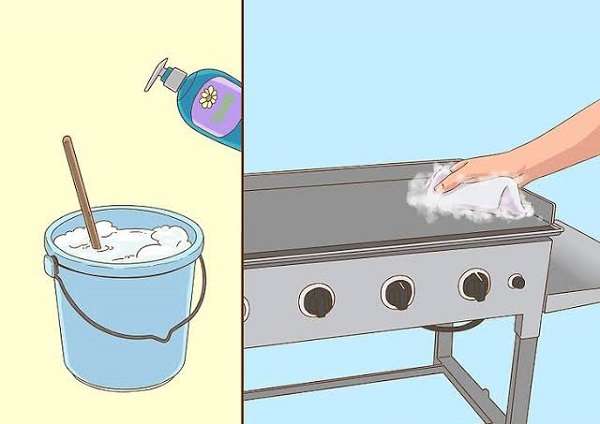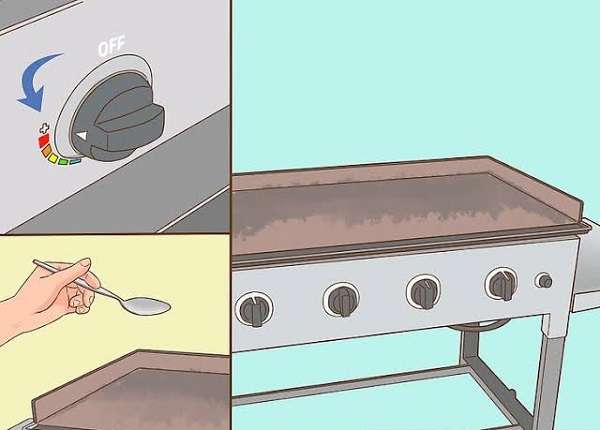If you have a new Blackstone Griddle then you are perhaps ready to fire it up. Are you ready?
Not so fast! Before cooking anything, it is highly suggested to season it in order to create a non-stick coat that adds taste to your food and stops scratching. With a few simple steps, you can coat your griddle plate and help your Blackstone last well into the future!
If you do these steps then you can overcome, many Blackstone griddle problems to avoid any unwanted incident.
Blackstone Griddle Problems and Solutions
A family can face many problems due to a lack of proper examination, cleaning, and Seasoning of their griddle.
In this piece of article, you will learn how to season and clean your griddle. And you may find the Top 6 Blackstone Grills Reviews here.
Cleaning and Seasoning Your Griddle
Clean your griddle with water and soap if it’s brand-new:
Fill up a 2-liter bucket with warm water. Add some soap and then whisk it in with a stick until it’s evenly mixed into the solution. Next, gently pour a small splash of the soapy water over the griddle. Grab some paper towels and rigorously rub the soap and water across the surface. Finally, wipe the surface of the griddle with a clean paper towel until it is dry.

Always wash a new griddle with soap prior to using it. This removes the cooking oil it is pre-seasoned with to prevent damage and rust during shipping.
If you are seasoning an old griddle, skip the step—applying soap on a used griddle can actually damage the plate coating permanently.
You may like: Top 5 Green Mountain Grills Reviews & Comparison
You may also like: 8 Green Mountain Grill Troubleshooting And Guide
Select oil that is ample in fatty acids to coat your grill:
Select your ideal oil from the following high-fat options: vegetable shortening, vegetable oil, flax oil, extra virgin olive oil, and coconut oil. You can also use lard if you want.
Always use oils that are high in fatty acids—indicated as a fats percentage on the nutrition information label—for optimal bonding with the griddle plate.
Avoid products with beyond fatty acids, which have been connected to health problems like coronary artery disease, weight gain, and liver abnormality.
Turn the burners to the maximum temperature and wait for 10 to 15 minutes:
Locate your propane tank and turn it on by rotating the valve anticlockwise. Now, set the burners to the maximum possible temperature and halt. Once you see the top of the griddle start to turn brown, you are ready to move on to the next step!

- Put on heat-resistant gloves for protection.
- Make definite your griddle is completely dry before turning on your burners.
- For griddles with specific temperature settings, turn the node to 350 °F (177 °C).
Spread 2 to 3 tablespoons of oil over the griddle surface:
Adding oil creates a natural non-stick surface and adds some taste to your food. Pour your special oil around the griddle and spread it equally across the surface using a paper towel. Use a pair of fire tongs to move the paper towel if you find your hands getting hot. Huddle down and inspect the layer of oil from the side to see if it is even.
- Be sure not to leave any dry spots or thick oil spill.
Wipe the edges, sides, and corners of your griddle with oil.:
Swab some oil onto a slice of paper towel or use the same one you used to wipe the surface. Now, use it to apply oil to the surviving parts of the griddle surrounding the top surface. Be sure to clean the sides facing outward from the griddle as well.
Leave the oil to cook for about 15 to 30 minutes or rest until it smokes:
After turning the griddle to the max, the top plate will slowly turn black. Keep patience until you see smoke starting to fill the air above the grill—this is called the “smoke point” and should happen after about 30 minutes. Once it does, keep waiting until all of the smoke vanishes.
Turn your griddle off and let it cool for 10 minutes:
Once all of the smoke has disappeared, turn your griddle off. After it has cooled down, you have completed one circle of seasoning. From here, you will continue doing this until you achieve the right level of seasoning. Grasp your hand about 1 inch over the griddle to see if it’s still hot.
Coat and heat your griddle 1 to 4 more times or until it’s dark brown.
Turn your griddle back to max and heat it up once more for another 10 to 30 minutes. Next, spread another even coating of oil onto the top and then rest for the smoke point again. Keep doing this until the top of the griddle turns inky brown—about 2 to 3 times is standard.
Mix up your oils to create divergent flavor synthesis. For example, use extra virgin olive oil for the first two rounds and top it off with coconut oil for the third round.
Wipe the griddle surface with cooking oil to finish it off.
The final touch is a quick sponge down with your oil of choice to prevent oxidation, also known as tarnish or rust. Before placing it into storage, pour some oil onto 2 to 3 paper towels and faintly wet the top of the grill. Be sure to wait until the grill has cooled before wetting it lightly.
Storing and Maintaining Your Seasoned Griddle
Store your griddle in a dry, cool place with a cover:
Place a deepened cover over your griddle to further prevent rusting and weather damage. Avoid storing it in muggy, hot areas—this can change your seasoning. If you are willing to make the backing, store your griddle in a carry bag, mainly if you are leaving it outdoors.
- Remain the zipper of your carry bag open 2 to 4 inches to prevent rusting.
Clean your griddle after each use with a paper towel and hot water:

Once you start using your griddle, each use will join to your layer of seasoning, so never clean it with soap. Ideally, use a spatula to softly scrape any food from the top. Next, clean the surface with a dry paper towel. For tougher spots of food remainder, fill up a 2-liter pail with boiling water. Gush it over the sturdy spot and leave the water to eat away at the remnant for about 5 minutes. Wipe the spot with a paper towel later
- Pour ¼ cup of salt over rigid areas to help the cleaning process.
Remove rust with steel wool or 40- to 60-grit sandpaper:
When you notice tarnish, remove it right away before it gets poor. Using either steel wool or low-grit sandpaper, rub the rusted spot completely until the erosion spots smooth over. Be sure to put a firm amount of pressure toward the rust spots as you scrub them.
- Purchase steel wool and sandpaper from home hardware stores and kitchen supply stores, severally.
Coat your griddle with a thin coat of oil after cleaning to maintain seasoning.
A papery coat helps sustain the seasoning bond and prevents rust growth. Choose any kind of cooking oil that you like for this procedure. You can even use non-stick cooking spray.
- Always coat your griddle after uprooting food buildup and rust.
- Supplementary, your griddle top should become blacker and more resistant to sticking. If it is not, you are not maintaining it appropriately.